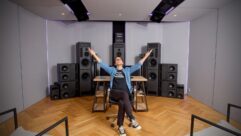Q & A: Loudspeakers
Under what circumstances does a 70 V, constant-voltage distributed loudspeaker system make more sense than multiple 8-ohm loudspeakers, and why?
Q: Under what circumstances does a 70 V, constant-voltage distributed loudspeaker system make more sense than multiple 8-ohm loudspeakers — and why?
A: Venue size determines the choice of a 70 V (technically 70.7 V) constant-voltage distributed loudspeaker system. For total power needs smaller than 500 W, a 70 V system steps up output voltage while stepping down output current. Therefore, the use of a 70 V system reduces wire size and cost. Power is the product of voltage X current, so for a specified power level there’s an infinite number of possibilities. For example, 100 W is 25 V at 4 amps, 10 V at 10 amps, or 100 V at 1 amp. If you have a system requiring 100 W with loudspeakers spread over an area of 10 acres, such as in a large factory sound system, wire size becomes important. In this example, using a 70.7 V system requires that the wire must carry 1.414 amps, while 8-ohm loudspeakers require 28.28 V at 3.54 amps — 2.5 times greater current draw, requiring bigger wire and increasing cost.
–Dennis Bohn, CTO, Rane










